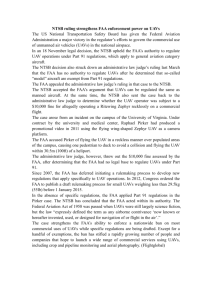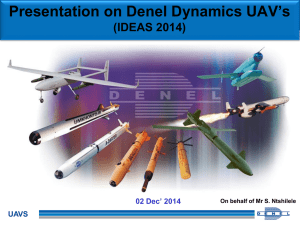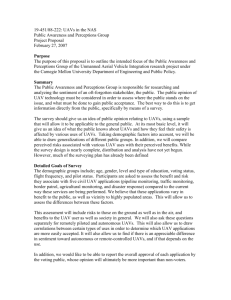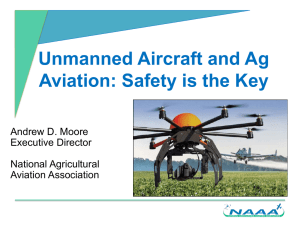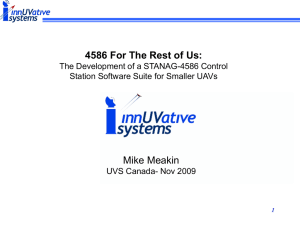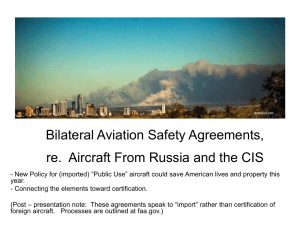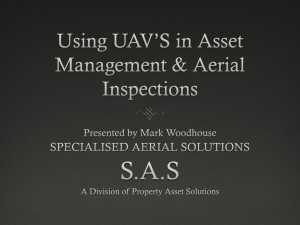NAAA Safety Concerns
advertisement
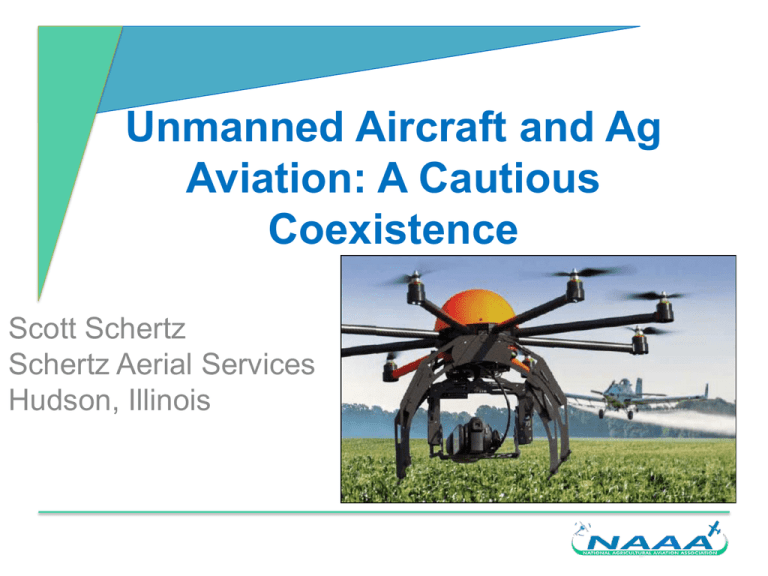
Unmanned Aircraft and Ag Aviation: A Cautious Coexistence Scott Schertz Schertz Aerial Services Hudson, Illinois Contents • The Importance of Ag Aviation • What is a UAV? • Implications of FAA Reauthorization • UAV Market Studies • NAAA’s Safety Concerns and Recommendations • Responsibility and Liability • Pirker Case and Recent Developments • • • • • The Importance of Ag 1,350 aerial applications Aviation businesses in the US 20 percent of all applied crop protection products on commercial farms 71 million acres of crop land each year Allows rapid treatment of large, remote areas and hard to reach areas Conducive to higher crop yields UAVs in the News Drones Find Fans Among Farmers, Filmmakers - The Wall Street Journal 3/10/14 AgEagle Soaring Toward UAS Success - Precision Ag 2/10/14 Commercial Agriculture Might Be Largest Beneficiary of UAVs - Springfield News-Leader 3/22/14 UAV or Model Aircraft? • The line between a UAV and a model aircraft was murky until recently – Model aircraft standards suggested by AC 91-57 Model Aircraft Operating Standards • The 2012 FAA reauthorization, the FAA Modernization and Reform Act (P.L.112-95), codified the definition of a model aircraft as one “strictly flown for hobby or recreational purposes.” The Act defines UAVs as commercial. FAA Reauthorization and Its Implications on UAVs • UAVs first mentioned in 2004 FAA Reauthorization (P.L. 108-176) • Extensive provisions provided in the 2012 reauthorization – Mandate for full integration by Sept. 30, 2015 – Propagation of special rules for UAVs under 55lbs (Now expected November 2014). – Selection of six test sites by late 2013 – Creation of UAS Roadmap Current FAA Policy • In Feb. 2007 the FAA issued a notice of policy in the Federal Register declaring that “no person may operate a UAV in the National Airspace System without specific authority.” • Established two methods of legal operation – Certificate of Waiver or Authorization (COA) – Special Airworthiness Certificate, Experimental Category (SAC-EC) • FAA recently issued first restricted category type certificate allowing the first commercial use of UAVs Aerial Application and UAVs • Booz Allen Study – Predicts UAV annual savings of $159 million for aerial application by 2035 and $186 million in crop input savings. • AUVSI Study – $13.6 billion economic impact within the first three years of integration, $82.1 billion between 2015 and 2025 • Several fallacies in the data used Issues With Study Estimates/Effectivess of UAVs • Extrapolated from the use of UAVs in Japan – 90 percent of crop protection in Japan is performed by UAVs (4 gallon RMAX helicopter) – Only 28 percent of Japanese farmers farm full-time – Average farm size in Japan is 1.5 hectares (3.7 acres), compared to 441 acres in the US. • • • AUVSI and Booz Allen studies are based on experimental technologies Both studies also assume full integration by 2015 The amount of air pushed down is exactly proportional to the weight of the aircraft that the air is holding up. A 40 pound helicopter does not displace much air. The UAV Safety Hazard • Since 2003 – 9.5 percent of aerial application accidents were the result of collisions with towers – 12.2 percent were the result of collisions with wires Fatal Air Tractor collision with a meteorological evaluation tower (MET). August 2013. NAAA Safety Concerns • UAV inability to “Sense and Avoid” – GAO: No adequate technology currently exists that would allow UAVs to sense and avoid other traffic • Security Concerns – UAV “spoofing” or hacking • “Lost Link” concerns – Many aircraft have no lost link procedure and continue flying until they hit a obstacle or run out of fuel NAAA Safety Concerns • Low-Level UAVs – Similar to birds except birds try to avoid collisions, they are very motivated and usually they take sufficient evasive action to avoid their peril – Birds are the second leading cause of aviation fatalities NAAA Safety Recommendations • NAAA is urging the FAA and Congress that UAVs be required to have: – ADS-B Out transponders – Strobe lights – Marking similar to that required for other lowlevel obstacles (aviation orange and white paint) – A minimum operating altitude of 1000 ft. above ground level for UAVs NAAA Safety Recommendations (continued) • A comprehensive database of UAV operations • Issuances of NOTAMs when UAVs are operating – FAA airworthiness certification for UAV • Pilot training: – Commercial pilots license – Class 2 Medical – Commercial Pesticide License if treating crops Recent Developments • Dec. 2013 - Announcement of UAV test sites – Alaska, Nevada, New York, North Dakota, Texas, Virginia • March 2014 Pirker v. Huerta Responsibility and Liability • A Financial Times Article reported on this issue on March 7th • According to the FAA UAS Integration Office liability in the event of a mid-air with a UAV puts the responsibility on the UAV operator to be responsible for collision avoidance • Regulatory uncertainty, certainty of Court involvement and near certain unmanned liability in the event of an accident puts UAV operations at great risk presently. Pirker v. Huerta • Raphael Pirker, a Swiss operator was fined $10,000 by the FAA “reckless” operation. • FAA maintains right to regulate under airspace regulation mandate • Currently on appeal to the full NTSB Conclusion • NAAA urges the FAA to take its time integrating UAVs into the national airspace and urges the agency to follow a comprehensive, well thought out safety-oriented approach using the association’s recommendations. • UAVs will not be used for spraying anytime soon, but have crop sensing and other non-application capabilities. Manned aircraft, such as ag aircraft are able to conduct crop sensing services too. • Considerable liability risk for UAV operators and providers. Questions?



